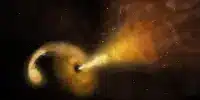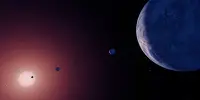To learn more about the structure of lightning storms, an astronaut and his new camera will gaze within them.
Andreas Mogensen, a European Space Agency astronaut, is planning a stormy follow-up to his 2015 research aboard the International Space Station. Mogensen, who has just arrived at the orbiting complex for a six-month mission, will take another look at lightning storms on Earth. Elusive phenomena he hopes to witness include “blue jets” (upside-down lightning) and “red sprites” (discharges in the mesosphere, a layer of the Earth’s atmosphere).
“There’s still a lot to understand exactly how they form, how they develop,” Mogensen told Space.com in July, before his Aug. 25 SpaceX Crew-7 launch. He noted that this will be “one of the more exciting studies” for the study team, as his 2015 photographs of blue jets graced the covers of both Science and Nature, the scientific community’s most respected journals.

Cameras in space have already photographed lightning, due to powerful satellites such as the American GOES (Geostationary Operational Environmental Satellite) series and the new European Meteosat Third Generation series. However, the human-led study allows for greater flexibility because it is easier to retask Mogensen on the fly when storms develop, assuming he is not preoccupied with anything that cannot be shifted in the timetable.
Two other factors are working in Mogensen’s favor. His previous journey lasted only 10 days; this time, he’ll be in space for at least six months. The new camera he brings with him, known as a Davis camera, is also novel: Based on what it observes, it can capture up to 100,000 photos each second.
According to Mogensen, the new camera “allows scientists to study the formation and development of these types of lightning in much greater detail.” And there’s still a lot to learn about how they grow and develop.”
The camera is neuromorphic, which means it uses a different image method than ordinary cameras. “Instead of taking images by collecting light through the camera shutter, the camera measures differences in light and uses that information to create an image,” ESA officials explained Thursday (Sept. 7).
“A Davis camera would not register a person sitting perfectly still in a lit room because the light does not change.” If the individual moves, a Davis camera will catch the shift in light and provide a video.”
According to Olivier Chanrion, the main author of the study’s April 2023 presentation at the European Geophysical Union in Vienna and online, staring at lightning provides a unique perspective on human-induced climate change.
“The interaction between these lightning events and the upper atmosphere is not fully understood,” Chanrion noted in the same press release. In addition, he is a senior researcher at DTU Space, Denmark’s leading space research institute.
According to Chanrion, the new study provides “the opportunity to analyze and quantify their (lightning storms’) impact, as well as to determine the extent to which they are associated with overshooting thundercloud tops that inject greenhouse gases and aerosols in the stratosphere.”















